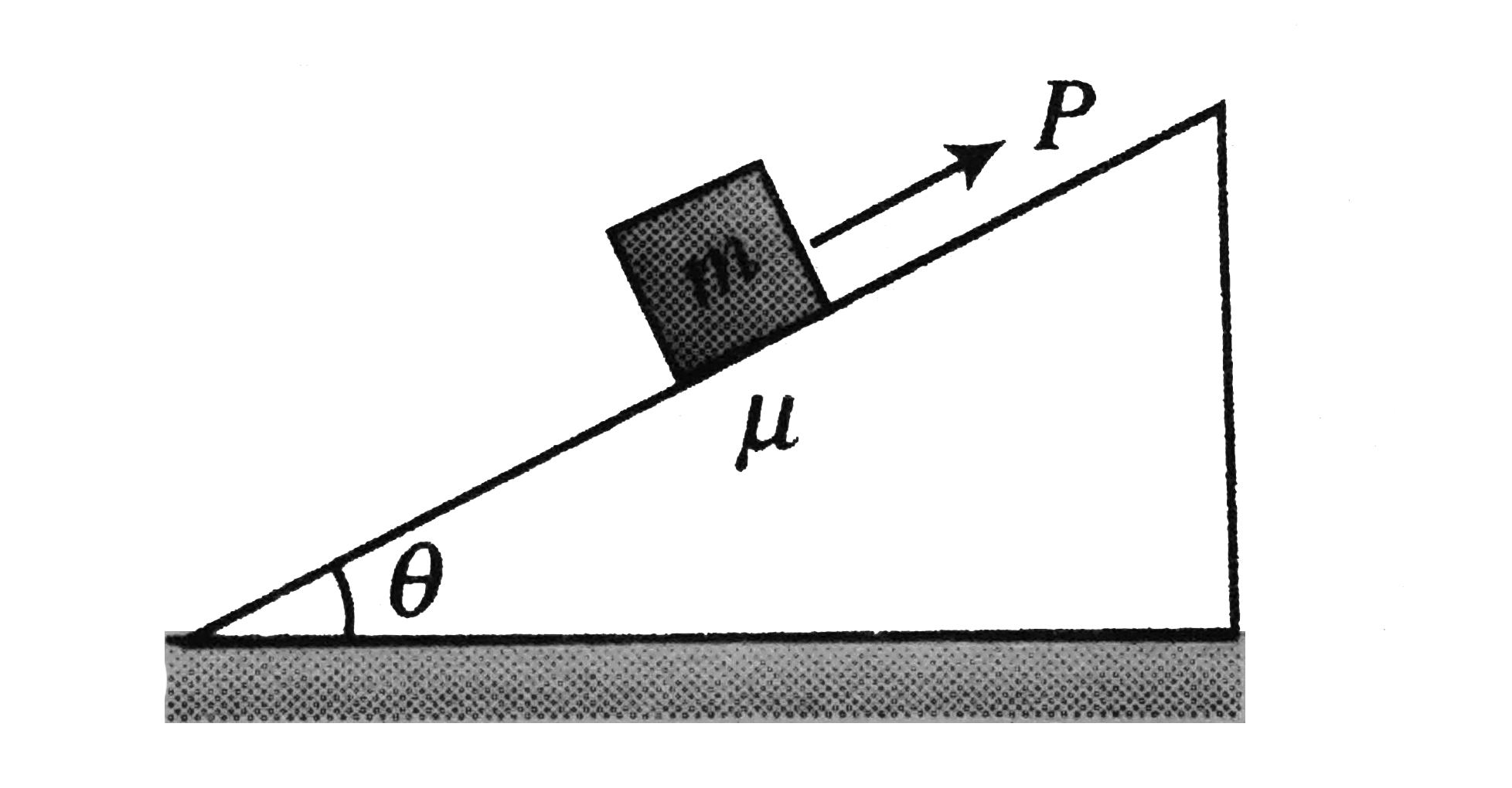A block of mass m is pulled by a constant powert P placed on a rough horizontal plane. The friction coefficient the block and surface is μ. The maximum velocity of the block is.
μPmg
μmgP
μmgP
Pμmg
The correct Answer is:D
To find the maximum velocity of a block of mass m being pulled by a constant power P on a rough horizontal plane with a friction coefficient μ, we can follow these steps:
Step 1: Understand the relationship between power, force, and velocity
The power P is defined as the product of force F and velocity v:
P=F⋅v
From this, we can express velocity as:
v=PF
Step 2: Identify the forces acting on the block
When the block is pulled on a rough surface, the forces acting on it are:
- The external force Fexternal pulling the block.
- The frictional force Ffriction opposing the motion.
The frictional force can be expressed as:
Ffriction=μ⋅N
where N is the normal force. On a horizontal surface, the normal force N is equal to the weight of the block:
N=mg
Thus, the frictional force becomes:
Ffriction=μmg
Step 3: Set up the condition for maximum velocity
At maximum velocity, the net force acting on the block is zero, which means the external force must equal the frictional force:
Fexternal=Ffriction=μmg
Step 4: Substitute the expression for external force into the power equation
Now we can substitute Fexternal into the power equation:
P=Fexternal⋅v
Substituting Fexternal=μmg:
P=(μmg)⋅v
Step 5: Solve for maximum velocity
Rearranging the equation to solve for v:
v=Pμmg
Conclusion
Thus, the maximum velocity of the block is given by:
vmax=Pμmg
The power P is defined as the product of force F and velocity v:
P=F⋅v
From this, we can express velocity as:
v=PF
When the block is pulled on a rough surface, the forces acting on it are:
- The external force Fexternal pulling the block.
- The frictional force Ffriction opposing the motion.
Ffriction=μ⋅N
where N is the normal force. On a horizontal surface, the normal force N is equal to the weight of the block:
N=mg
Thus, the frictional force becomes:
Ffriction=μmg
At maximum velocity, the net force acting on the block is zero, which means the external force must equal the frictional force:
Fexternal=Ffriction=μmg
Now we can substitute Fexternal into the power equation:
P=Fexternal⋅v
Substituting Fexternal=μmg:
P=(μmg)⋅v
Rearranging the equation to solve for v:
v=Pμmg
Thus, the maximum velocity of the block is given by:
vmax=Pμmg
Topper's Solved these Questions
- BOOK - DC PANDEY ENGLISHCHAPTER - WORK, POWER AND ENERGYEXERCISE - A Only One Option is Correct42videos
WORK, POWER AND ENERGY
- BOOK - DC PANDEY ENGLISHCHAPTER - WORK, POWER AND ENERGYEXERCISE - B More than One Option is Correct26videos
WORK, POWER AND ENERGY
- BOOK - DC PANDEY ENGLISHCHAPTER - WORK, ENERGY AND POWEREXERCISE - MEDICAL ENTRACES GALLERY33videos
WORK, ENERGY AND POWER
Similar Questions
A block of mass m is pulled by a force of constant power P placed on a rough horizontal plane. The friction coefficient between the block and the surface is μ. Then
View SolutionA block of 10kg is pulled at a constant speed on a rough horizontal plane by a force of 20N. Calculate the coefficient of friction ?
View SolutionA block of mass m is moving with a constant acceleration a on a rough horizontal plane. If the coefficient of friction between the block and ground is μ, the power delivered by the external agent in a time interval t from the beginning is equal to:
View SolutionA block of mass M is pulled along a horizontal surface by applying a force at angle θ with the horizontal. The friction coefficient between the block and the surface is μ. If the block travels at a uniform velocity, find the work done by this applied force during a displacement d of the block.
View SolutionA block of mass M is pulled along a horizontal surface by applying a force at angle θ with the horizontal. The friction coefficient between the block and the surfasce is μ. If the block travels at a uniform velocity, find the work donen by this applied force during a displacement d of the blcok.
View SolutionA block of mass M is being pulley along horizontal surface .The coefficient of friction the block and the surface is μ If another block of mass M/2 is placed on the block and it is pulled is again pulled on the surface , the coefficient of friction the block and the surface will be
View SolutionA block of mass M is kept on as rough horizontal surface. The coefficient of static frictionbetween the block and the surface is μ. The block is to be pulled by applying a force to it. What minimum force is needed to slide the block? In which direction should this force act?
View SolutionA block of mass M is kept on as rough horizontal surface. The coefficient of static friction between the block and the surface is μ. The block is to be pulled by applying a force to it. What minimum force is needed to slide the block? In which direction should this force act?
View SolutionA block of mass m is being pulled up a rough incline by an agent delivering constant power P. The coefficient of friction between the block and the incline is μ. The maximum speed of the block during the course of ascent is
 View Solution
View SolutionTwo block of masses m1 and m2 connected by a light spring rest on a horizontal plane. The coefficient of friction between the block and the surface is equal to μ. What minimum constant force has to be applied in the horizontal direction to the block of mass m1 in order to shift the other block?
View Solution

